During LEAP 2025, Telecom Review spoke with Roque Lozano, Senior Vice President of Network Infrastructure MEA at Nokia to explore the evolution of the company’s network infrastructure and the importance of efficient network design and sustainability.
Lozano emphasized that Nokia is collaborating with regional governments to support local infrastructure needs, particularly in terms of power consumption, and is investing in high-capacity fiber networks to enhance connectivity across borders.
Nokia’s goal is to provide premium, reliable, and flexible connectivity that caters to digital services in the Middle East and Africa.
In light of Nokia's recent focus on integrating artificial intelligence (AI), the Internet of Things (IoT), and edge computing into its network infrastructure solutions, how will these technologies shape the evolution of network architecture in the MEA region?
To aptly portray Nokia’s perspective on these promising new technologies, let me first simplify it into two main streams. Firstly, we aim to build networks for the AI era, or what I would call the AI generation. At the same time, we leverage AI to enhance our networks, making them more efficient and capable of delivering AI-as-a-Service (AIaaS).
To achieve this, we have structured our research and development (R&D) and service operations in such a way that they fully understand the evolving demands of AI. While AI itself is not entirely new, the requirements it imposes—such as near-zero latency, increasingly stringent boundary conditions, resilient key performance indicators (KPIs), and the need for quantum-safe security in both Internet Protocol (IP) and optical domains—are more critical now than ever before.
We recognize that this transformation is not only reshaping the network architecture; it is reshaping entire economies and social infrastructures.
Across the Middle East and Africa, countries are making significant investments in digital research, with AI-driven digital decision-making becoming increasingly vital.
Our first priority is securing and certifying data as this will ensure its integrity across the entire AI-driven ecosystem. Since AI operates as a distributed cloud service, these cloud services must be well-defined, secured, transported, and made easily accessible to users. This requires seamless connectivity between users and large data centers. However, data centers themselves are evolving; they are becoming more disaggregated. Rather than relying on centralized computing located far from the user, functions are being pushed closer to the edge to optimize efficiency.
This shift is only possible with a highly reliable and adaptable network—one that can dynamically redistribute workloads based on service-level agreements (SLAs), demand fluctuations, traffic conditions, and network status. Networks are not static; they can face disruptions due to incidents or unforeseen events. In that sense, the network behaves like a wild animal, and we have to make sure that no matter what happens, there is always an alternative way to maintain stable services and uphold SLAs, ultimately guaranteeing a seamless user experience.
While this may sound simple, achieving true end-to-end connectivity—from data centers to the edge, to service providers, and finally to the end user, whether they be a consumer or a professional in a mission-critical role—is incredibly complex. That’s why we emphasize premium connectivity as the foundation for premium digital services.
At Nokia, we believe that connectivity alone is not enough; it must be rock-solid, trustworthy, reliable, and flexible.
Only with such a foundation can businesses and enterprises unlock the full potential of AI and cloud-based digital services.
How will Nokia’s infrastructure address the environmental challenges associated with network deployments in the Middle East and Africa, especially in energy-intensive markets?
Our first mission is to reduce power consumption and carbon dioxide (CO₂) emissions per transported bit. However, with traffic multiplying by a factor of 10, we cannot yet determine if we will achieve this reduction as quickly as traffic is growing. Nonetheless, our primary goal is to minimize energy usage as much as possible by leveraging the latest technology. Through these technologies, we can use the most powerful chips while operating with less power.
Beyond energy efficiency, we also emphasize the importance of network architecture and services to ensure a first-time-right approach.
This means minimizing waste and continuously learning from past experiences to prevent future mistakes. It’s a holistic strategy through which, despite increasing network capacity and power consumption, the network will become even more valuable to society, enabling remote work, improving safety, and reducing transportation and other resource-intensive activities.
When viewed in isolation, optimizing the network's energy use might seem like a challenge; however, when considered in the broader context, it simplifies operations and enhances efficiency across industries, making it an essential driver of sustainability and progress.
What specific steps is Nokia taking to address regional infrastructure needs while ensuring seamless collaboration with local governments or any other stakeholders?
We are definitely seeing significant efforts from governments. They are establishing the regulations and foundational infrastructure necessary for deploying network infrastructure, including critical elements such as power.
Power is a major requirement for data centers, artificial intelligence, and cloud services.
In some regions, this demand is leading to the construction of new power stations, particularly in the Middle East and, more specifically, in Saudi Arabia, where we are now. Here, the government has a clear advantage in facilitating the adoption and localization of data centers as it leverages digital intelligence to support national, regional, and even global needs.
Another key trend we have observed is that connectivity is expanding beyond national boundaries. Cloud services are no longer limited to a single operator, customer, or country; they are now inherently regional.
The ability to provide seamless connectivity—both within a country and across borders—has become a crucial factor.
In particular, we are seeing a surge in projects that aim to expand fiber networks and enhance cross-border connectivity. This trend is closely linked to the growth of submarine cables, which are increasing in number, landing stations, and capacity. Ultimately, these developments not only enable efficient transit traffic but also position regions as attractive digital hubs, catalyzing the establishment of cloud services and drawing newfound investments.
More Exclusives with Lozano:
Innovating Tomorrow: Nokia's Perspective on Connectivity at LEAP 2024
Nokia Delivering Inclusive and Affordable Broadband for All in the MEA
Nokia Combines Large and Diverse Set of Capabilities for Network Transformation











